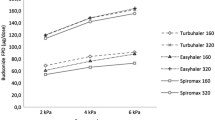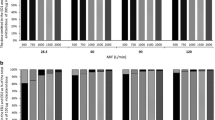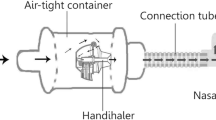Abstract
Objectives: The aim of this in vitro study was to determine the delivered dose of budesonide 200μg via a chlorofluorocarbon-free pressurized metered dose inhaler (pMDI) when administered through different spacers in tidal breathing patterns of young children.
Methods: Tidal breathing was simulated for toddlers and children. Spacers tested were Babyhaler®, AeroChamber® Plus small and medium; the pMDI was Budiair® 200μg. Output was measured after one actuation and five inhalations in primed and unprimed spacers. Cumulated output was evaluated after each of five simulated inhalations. Aerosol characteristics — i.e. particle size distribution of the output — were determined in primed spacers with a cascade impactor using high-performance liquid chromatography and UV detection.
Results: Total output from primed spacers after five inhalations was determined between 37.9μg and 40.9μg with little differences between spacers and breathing patterns. About 58–79% of this total output was inhaled with the first breath from the AeroChamber® Plus and about 26% from the Babyhaler®. The fine particles <5μm ranged between 87% and 92% of the delivered dose for all three spacers.
Discussion and Conclusion: The nominal dose (200μg) of the Budiair® 200μg inhaler is reduced to 40μg delivered dose or less by using Babyhaler® and AeroChamber® Plus spacers taking five breaths. With a single breath the delivered dose can be reduced further to a minimum of 10μg using the Babyhaler®. Clinical studies are warranted in the future for decisions on ’clinical efficacy’, safety, and exact dose adjustment.





Similar content being viewed by others
Notes
1 The use of trade names is for product identification purposes only and does not imply endorsement.
2 Outside the spacer: 40% of the nominal dose pass the spacer and 90% of these particles are smaller than 4.9μm (= respirable fraction.)
References
Ross DL, Schultz RK. Effect of inhalation flow rate on the dosing characteristics of dry powder inhaler (DPI) and metered dose inhaler (MDI) products. J Aerosol Med 1996; 9: 215–26
Smith KJ, Chan HK, Brown KF. Influence of flow rate on aerosol particle size distributions from pressurized and breath-actuated inhalers. J Aerosol Med 1998; 11: 231–45
Everard ML, Devadason SG, LeSouéf PN. Flow early in the inspiratory maneuver affects the aerosol particle size distribution from a Turbohaler. Respir Med 1997; 91: 624–8
Leach CL. Improved delivery of inhaled steroids to the large and small airways. Respir Med 1998; 92: 3–8s
Feddah MR, Davies NM, Gipps EM, et al. Influence of respiratory spacer devices on aerodynamic particle size distribution and fine particle mass of beclomethasone from metered-dose inhalers. J Aerosol Med 2001; 14: 477–85
Asmus MJ, Liang J, Coowanitwong I, et al. In vitro performance characteristics of valved holding chamber and spacer devices with a fluticasone metered-dose inhaler. Pharmacotherapy 2004; 24: 159–66
Terzano C, Mannino F. Aerosol characterization of three corticosteroid metered dose inhalers with volumatic holding chambers and metered dose inhalers alone at two inspiratory flow rates. J Aerosol Med 1999; 12: 249–54
Janssens HM, Krijgsman A, Verbraak TFM, et al. Determining factors of aerosol deposition for four pMDI-Spacer combinations in an infant upper airway model. J Aerosol Med 2004; 17: 51–61
Everard ML, Clark AR, Milner AD. Drug delivery from holding chambers with attached facemask. Arch Dis Child 1992; 67: 580–5
Mitchell JP, Nagel MW. In vitro performance testing of three small volume-holding chambers under conditions that correspond with use by infants and small children. J Aerosol Med 1997; 10: 341–9
Berg E, Madsen J, Bisgaard H. In vitro performance of three combinations of spacers and pressurized metered dose inhalers for treatment in children. Eur Respir J 1998; 12: 472–6
Finlay WH, Zuberbuhler P. In vitro comparison of beclomethasone and salbutamol metered-dose inhaler aerosols inhaled during pediatric tidal breathing from four valved holding chambers. Chest 1998; 114: 1676–80
Barry PW, O’Callaghan C. The output of budesonide from spacer devices assessed under simulated breathing conditions. J Allergy Clin Immunol 1999; 104: 1205–10
Janssens HM, De Jongste JC, Hop WC, et al. Extra-fine particles improve lung delivery of inhaled steroids in infants: a study in an upper airway model. Chest 2003; 123: 2083–8
Usmani OS, Biddiscombe MF, Nightingale JA, et al. Effects of bronchodilator particle size in asthmatic patients using monodisperse aerosols. J Appl Physiol 2003; 95: 2106–12
Ganderton D, Lewis D, Davies R, et al. The formulation and evaluation of CFC-free budesonide pressurized metered dose inhaler. Respir Med 2003; Suppl. D: S4–9
US Pharmacopeia. Physical tests and determinations: aerosols. Rockville (MD): United States Pharmacopeia, USP Convention Inc., 2nd Supplement 2003; chapter 601: 2105–23
Berg E, Asking L, Svensson JO. Is it possible to measure the particle size distribution from a pMDI/spacer during simulated breathing? Eur Respir J 1997; 10: 81s
O’Callaghan C, Lynch J, Robertson C. Improvement in sodium chromoglycate delivery from a spacer device by use of an antistatic lining, immediate inhalation, and avoiding multiple actuations of drug. Thorax 1993; 48: 603–6
Council of Europe. Preparations for inhalation: aerodynamic assessment of fine particles. European Pharmacopoeia 2002, Council of Europe, Strasbourg, France. 3rd Supplement 2001: 113–24
Kenyon CJ, Thorsson L, Borgström L, et al. The effects of static charge in spacer devices on glucocorticosteroid aerosol deposition in asthmatic patients. Eur Respir J 1998; 11: 606–10
Pierart F, Wildhaber JH, Vrancken I, et al. Washing plastic spacers in household detergent reduces electrostatic charge and greatly improves delivery. Eur Respir J 1999; 13: 673–8
Janssens HM, Devadason SG, Hop WC, et al. Variability of aerosol delivery via spacer devices in young asthmatic children in daily life. Eur Respir J 1999; 13: 787–91
Turpeinen M, Nikander K, Malmberg LP, et al. Metered dose inhaler add-on devices: is the inhaled mass of drug dependent on the size of the infant? J Aerosol Med 1999; 12: 171–6
Thorsson L, Edsbacker S. Lung deposition of budesonide from a pressurized metered-dose inhaler attached to a spacer. Eur Resp J 1998; 12: 1340–5
Onhoj J, Thorsson L, Bisgaard H. Lung deposition of inhaled drugs increases with age. Am J Respir Crit Care Med 2000; 162: 1819–22
Janssens HM, Heijnen EM, de Jong VM, et al. Aerosol delivery from spacers in wheezy infants: a daily life study. Eur Respir J 2000; 16: 850–6
Acknowledgments
A study grant was given by Asche Chiesi GmbH, Hamburg, Germany.
The authors wish to thank Dr Frank Erdnüss for his help in preparing this manuscript.
No sources of funding were used to assist in the preparation of this article, and the authors have no conflicts of interest that are directly relevant to the content of this study.
Author information
Authors and Affiliations
Corresponding author
Rights and permissions
About this article
Cite this article
Kamin, W., Ehlich, H. In Vitro Comparison of Output and Particle Size Distribution of Budesonide from Metered-Dose Inhaler with Three Spacer Devices during Pediatric Tidal Breathing. Treat Respir Med 5, 503–508 (2006). https://doi.org/10.2165/00151829-200605060-00013
Published:
Issue Date:
DOI: https://doi.org/10.2165/00151829-200605060-00013




